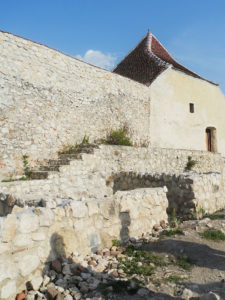Barcarozsnyó castle

Barcarozsnyó (Râșnov, Rosenauis) is in Transylvania, its fort was a Saxon “peasant castle”, it was built in the Kingdom of Hungary and after 1918 it became part of Romania. The Saxon settlement was an agricultural town and it is located northwest of Brassó (Brasov, Kronstadt) in the Keresztény Mountain, on the top of the castle hill that is 150 meters high. There are only two roads leading into the castle, and only one of them is wide enough for a wagon. The well of the castle can be found in the castle yard, it is 146 meters deep, completed between 1623 and 1640. The chapel of the castle is near to it, it was built in 1650.
According to a few historians, the fort was built by the Teuton Order of Knights who had been invited to Hungary during the reign of King Endre II in the 13th century. As the German knights were driven out only after 12 years, this theory is debated. It is more likely that the stronghold was constructed at the end of the 14th century or at the beginning of the 15th century when the Ottoman raids began to threaten Transylvania.

Indeed, as the Turks raided the settlement as early as 1421, the fort had a greater significance. The castle went to the settlement’s possession in 1427 and the Hungarian king, King Zsigmond of Luxembourg who was presently staying there, awarded them the right to keep markets. The inhabitants strengthened the castle and built more fortification. Allegedly, they stored their food and valuables behind the strong walls but others say these fortifications were built only after 1612.

However, the settlement was in a danger zone, the Turks were destroying the area in 1513. We know that elected King János Zsigmond visited the castle in 1562. The Ottoman threat didn’t cease to exist and Barcarozsnyó castle was burned down in 1585. It is not surprising that the Saxon burghers enjoyed a tax exemption (25 Gold Forints annually since 1540) that they had to spend on the castle’s construction.

Prince Báthori Gábor besieged the fort because of the Saxons’ resistance against his power in 1612. He could only take the castle in two days because the defenders ran out of drinking water. Others say that the burghers, led by Judge Peter Düzmen surrendered only after seven days, though. However, the Prince gave a pardon to the Saxons a year later, giving them back Barcarozsnyó and Törcsvár (Bran) castles at the same time. They mended the castle and immediately began to dig the above-mentioned well which cost them 2,000 Gold Forints and lasted for 28 years. They built an additional keep for the animals that were 2-acre-big and surrounded it with a wall and a strong gate tower.

As a result of the fortifications, the Crimean Tatars could not take it in 1655 or 1658. The walls were strong enough to repel the siege of Chancellor Mikes Mihály, the man of Prince Rákóczi György II in 1660, too. You can read more about the wars raging in Transylvania in those years here:
The Saxons were overjoyed to open the gates before the German mercenaries in 1688 but they sacked it, led by Count Louis of Baden. The castle was taken by Prince Rákóczi Ferenc during his War of Independence but the Austrian General Rabutin burned the town in 1708 and the fire spread to the castle, too. Unfortunately, most of the buildings of the castle, including the old tower collapsed during a great earthquake in 1802.

Photo: Danycid
Dear Readers, I can only make this content available through small donations or by selling my books or T-shirts.
If you like my writings, please feel free to support me with a coffee here:
You can check out my books on Amazon or Draft2Digital, they are available in hardcover, paperback, or ebook:
https://www.amazon.com/dp/198020490X
or at https://books2read.com/b/boYd81


My work can also be followed and supported on Patreon: Become a Patron!http://Become a Patron!


https://hungarianottomanwars.myspreadshop.com/all
Here are a few more pictures of Barcarozsnyó castle:



































